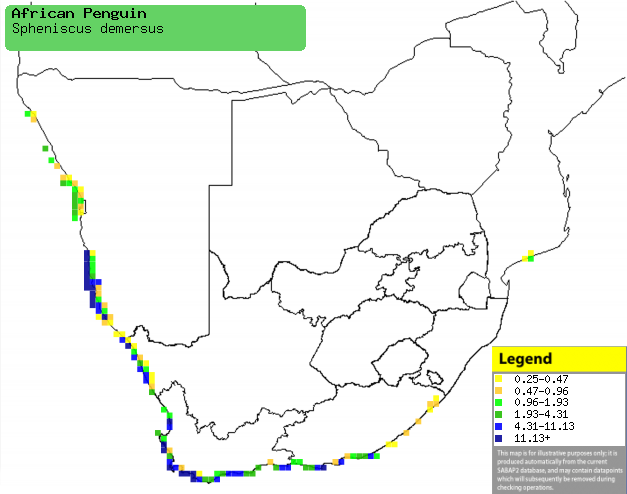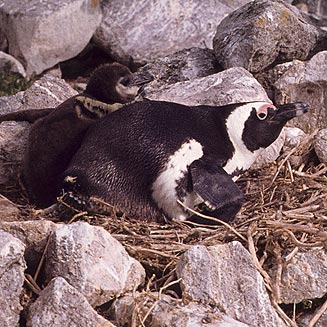|
Spheniscus demersus (African
penguin, Jackass penguin)
Brilpikkewyn [Afrikaans]; Inguza, Unombombiya [Xhosa];
Zwartvoetpinguïn, Brilpinguïn [Dutch]; Manchot du Cap [French]; Brillenpinguin
[German]; Pinguim do Cabo [Portuguese]
Life
> Eukaryotes >
Opisthokonta
> Metazoa (animals) >
Bilateria >
Deuterostomia > Chordata >
Craniata > Vertebrata (vertebrates) > Gnathostomata (jawed
vertebrates) > Teleostomi (teleost fish) > Osteichthyes (bony fish) > Class:
Sarcopterygii (lobe-finned
fish) > Stegocephalia (terrestrial
vertebrates) > Tetrapoda
(four-legged vertebrates) > Reptiliomorpha > Amniota >
Reptilia (reptiles) >
Romeriida > Diapsida > Archosauromorpha > Archosauria >
Dinosauria
(dinosaurs) > Saurischia > Theropoda (bipedal predatory dinosaurs) >
Coelurosauria > Maniraptora > Aves
(birds) > Order: Ciconiiformes
> Family: Spheniscidae
Distribution and habitat
Endemic to southern Africa, occurring along the coast of
Namibia and the Western and Eastern Cape, while it is a vagrant to southern
Mozambique and Gabon. There are 29 colonies spread out across the coastline,
most of which are positioned on islands with flat sandy ground or steep, rocky
embankments with sparse vegetation. There are some on the mainland as well,
mainly in inaccessible caves or at suburban or even partially urban sites around
Cape Town and Port Elizabeth.
|
 |
|
Distribution of African penguin in southern Africa,
based on statistical smoothing of the records from first SA Bird Atlas
Project (©
Animal Demography unit, University of
Cape Town; smoothing by Birgit Erni and Francesca Little). Colours range
from dark blue (most common) through to yellow (least common).
See here for the latest distribution
from the SABAP2. |
Predators and parasites
- Predators
- of adults
- Carcharodon carcharias (Great white shark)
- Orcinus orca (Killer whale)
- Arctocephalus pusillus (Cape fur seals)
- Panthera pardus (Leopard)
- of eggs
- of chicks and eggs
- Parasites
- external (ectoparasites)
- Parapsyllus longicornis (fleas)
- Ornithodoros capensis (ticks)
- internal (endoparasites)
- cestodes
- Tetrabothrius lutzi
- Tetrabothrius eudyptidis
- nematodes
- Plasmodium relictum (avian malaria)
- Babesia peircei (piroplasm)
- Pasteurella multocida (avian cholera)
- Cardiocephaloides physalis (trematodes)
Movements and migrations
It usually stays within three kilometres of the
colony when breeding, however in the non-breeding season it may
travel up to roughly 400 km away on foraging trips. It prefers to
forage near the coast, however it has occasionally been recorded
about 100 km out to sea.
Food
It mainly eats pelagic schooling fish, supplemented with
aquatic invertebrates, foraging either alone or in small groups, often alongside
Cape gannets,
Sooty shearwaters,
Cape cormorants,
Kelp gulls,
terns and marine mammals. Adults often work
together to surround and trap a shoal, catching them from below before
swallowing the fish underwater and returning to the surface. It may also pursue prey
downwards up to a depth of roughly 130 m, usually less than 50 m. Foraging trips
are usually less than 24 hours long when there are chicks to feed, but when not
breeding it may stay out to sea for up to about five days. The following food items have been recorded
in its diet:
- Fish
- Sardinops sagax (Sardines)
- Sufflogobius bibartus (Pelagic gobies)
- Trachurus trachurus (Horse mackerel)
- Merluccius (hakes)
- Scomberesox saurus (Sauries)
- Engraulis encrasicolus (Anchovies)
- Liza richardsonii (Southern mullet)
- Etrumeus whiteheadii (Round herring)
- Gymnammodytes capensis (Cape sandlances)
- Thyrsites atun (Snoek
- Scomber japonicus (Chub mackerel)
- Syngnathus (pipefish)
- Invertebrates
- polychaetes
- crustaceans
- Jasus lalandii (Cape rock lobster)
- Pterygosquilla armata (Cape mantis shrimp)
- crab larvae
- cephalopods
- Loligo vulgaris (Chokka)
- Heteroteuthis (bobtail squids)
- Argonauta argo (Paper nautilus)
Breeding
- Monogamous, with pairs usually staying together for at least four days.
Males perform a display to convey the ownership of their territory, in which
it stands with its head and bill and skywards while calling loudly. It is a
colonial nester, breeding in tightly-packed colonies (see image below right)
of up to about 21 400 pairs (Dassen Island, Western Cape).
- The nest is usually a burrow dug by both both sexes in guano or sand,
roughly 56 cm deep and often lined with seaweed, bones, feathers and pieces
of vegetation. It is typically placed in cavities between rocks, concealed
by vegetation or out in the open.
 |
 |
|
African penguin on nest. [photo H.
Robertson ©] |
Colony of African penguins, Rooi Els, South
Africa. [photo Jim Scarff ©] |
- Egg-laying season peaks from September-December in central Namibia,
April-May in Lambert's Bay, February-August at Malgas Island, Marcus Island
and Stony Point, January-August at Robben Island and from June-December at
Dassen Island.
- It lays 1-3 eggs at roughly three day intervals, which are incubated
equally by both sexes for about 38-41 days, alternating incubation duties
every 1-2 days.
- The chicks are constantly brooded in alternating shifts by their parents for the first five days
of their lives. By the time they reach 26-30 days old, it is necessary for
both parents to forage simultaneously, still returning regularly to the nest
regularly to regurgitate food. The young may form crèches at this age, losing their down feathers when they become 41-45 days old, leaving the
nest at 64-86 days of age and becoming fully independent 44-66 days later.
At this point in their lives they disperse from the colony, travelling up to
about 1900 km; they either return to breed later or they move to a different
colony.
Threats
Vulnerable, due to a continually decreasing
population since the early 1900s, largely caused by fisheries reducing fish
stocks and resulting in starvation of chicks and adults. In 2003 its global
population was estimated to be 201 000 adults. Oil spills are also a serious
concern, as penguins are flightless and cannot avoid them, so each event
often results in tends of thousands of African penguin deaths.
References
-
Hockey PAR, Dean WRJ and Ryan PG 2005. Roberts
- Birds of southern Africa, VIIth ed. The Trustees of the John Voelcker
Bird Book Fund, Cape Town.
|
